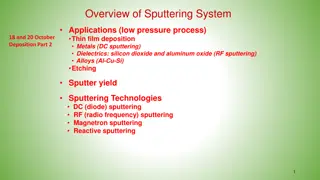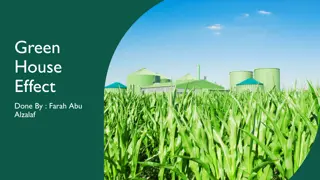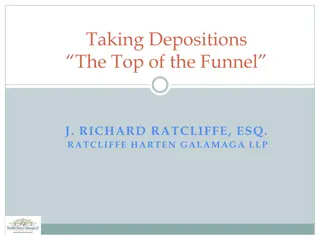Brain Mineral Deposition and Cognitive Decline Study
Investigating the progression pattern of brain mineral deposition as a differential indicator of cognitive decline in individuals with varying cognitive statuses from normal to Alzheimer's disease. The study aims to develop improved imaging techniques and specific cognitive-relevant atlases to under
4 views • 24 slides
Understanding the Basic Principles of Distillation
Distillation is a process used to separate components in a liquid mixture based on differences in vapor pressures. This involves techniques like simple, steam, and fractional distillation, as well as understanding binary mixtures, boiling points, vapor pressures, and vapor-liquid equilibria. Raoult'
5 views • 42 slides
Atomic Layer Deposition Equipment Market Size, Trends, Forecast Research 2032
The global atomic layer deposition equipment market size was USD 3.9 Billion in 2023 and is projected to reach USD 9.2 Billion by 2032, expanding at a CAGR of 10% during 2024\u20132032.
0 views • 4 slides
Efflorescence and Exsiccation in Chemistry
Efflorescence refers to the process where a substance loses water to form a lower hydrate or becomes anhydrous due to differences in vapor pressures. Hydrates with vapor pressures greater than the atmosphere tend to exhibit efflorescence. The rate of efflorescence increases with temperature. Exsicca
0 views • 103 slides
Chemical Deposition Techniques in Solid State Physics
Chemical deposition is a fabrication technique using different chemicals for reactions, allowing coatings to form successfully. Techniques include spray pyrolysis, electrochemical deposition, dip coating, and more. Spray pyrolysis, cost-effective and versatile, is used in various commercial processe
1 views • 25 slides
Understanding Amyloidosis: Causes, Types, and Pathological Characteristics
Amyloidosis is a disorder characterized by the deposition of abnormal amyloid fibrils in tissues, impacting various organs. This condition is associated with different types of amyloid, such as AA and AL amyloid. The deposition of amyloid can lead to tissue damage and organ dysfunction. Primary and
1 views • 11 slides
Understanding Sputtering Systems for Thin Film Deposition
Sputtering systems, including DC and RF sputtering, are used for thin film deposition of metals, dielectrics, and alloys. This process involves ejecting atoms from a solid target material through bombardment by energetic particles. The efficiency of sputtering is measured by sputter yield, which dep
0 views • 35 slides
Physical Vapor Deposition Market
The Global Physical Vapor Deposition Market size is expected to be worth around USD 7 Billion by 2033, from USD 3.2 Billion in 2023, growing at a CAGR of 8.1% during the forecast period from 2024 to 2033.\nClick here for request a sample : \/\/market
1 views • 4 slides
Understanding Earth's Landforms: Erosion, Deposition, and Weathering
Explore the processes of erosion, deposition, and weathering that shape Earth's landforms over time. From the breakdown of rock through weathering to the movement of eroded material by erosion and the settling of sediments by deposition, witness the continuous transformation of Earth's surface. Disc
1 views • 14 slides
Understanding Arthritis: Diagnosis and Pathophysiology
Joint pain can result from various factors such as inflammation, cartilage degeneration, crystal deposition, infection, or trauma. Different pathophysiologic processes necessitate clinical evaluation and identification through history, physical examination, and understanding of joint disease types.
2 views • 49 slides
Global Physical Vapor Deposition Market
The Global Physical Vapor Deposition Market Size is Anticipated to Exceed USD 60.06 Billion by 2033, Growing at a CAGR of 8.40% from 2023 to 2033.\n\n
0 views • 8 slides
Colligative Properties in Solutions: Vapor Pressure, Freezing Point Depression, and Osmotic Pressure
Colligative properties such as vapor pressure lowering, freezing point depression, and osmotic pressure are characteristics of solutions that depend on the number of solute particles present. This text explores how these properties are related to the concentration of solute in a solution and how the
0 views • 14 slides
Chemical Vapor Deposition (CVD) Methods for Nanomaterials Characterization
Chemical Vapor Deposition (CVD) is a widely used method in the field of nanomaterial synthesis, particularly for growing nanotubes, nanowires, and nanoparticles. The process involves decomposing a gaseous precursor on a substrate with the help of a catalyst, either predeposited or provided in the ga
3 views • 8 slides
Field Sedimentology: Methods and Tools for Sedimentary Studies
Sedimentology involves interpreting sediments and rocks in terms of transport and deposition processes, distribution in space and time. Field studies require basic equipment like a notebook, hand lens, compass, clinometer, hammer, and GPS. Palaeocurrent indicators provide evidence of flow direction
0 views • 28 slides
Understanding the Greenhouse Effect and Its Impact
The greenhouse effect is the trapping of the sun's warmth in a planet's lower atmosphere, primarily by greenhouse gases like carbon dioxide and water vapor. These gases absorb and re-emit infrared radiation, which leads to an increase in temperatures. While carbon dioxide and water vapor are signifi
1 views • 13 slides
Overview of Physical Vapor Deposition (PVD) Techniques in Thin Film Deposition
Physical Vapor Deposition (PVD) includes various vacuum techniques for depositing thin films on substrates through physical means. This method involves a dry vacuum process to coat objects with different materials. PVD processes utilize methods like Mechanical, Evaporation, Sputtering, Ion plating,
0 views • 31 slides
Study on MgO Deposition Using (CpEt)2Mg and H2O
Investigation conducted in April 2014 on MgO deposition process using (CpEt)2Mg and H2O. Initial attempts showed non-uniformity, with subsequent optimization leading to uniform deposition on MCPs. Thickness measurements taken on Si and MCPs revealed reproducible results with slight depletion in prec
0 views • 8 slides
Exploring Fused Deposition Modeling (FDM) Technology
Fused Deposition Modeling (FDM) is an additive manufacturing technology developed in the late 1980s. This process involves laying down molten material in layers using a heated nozzle, making it ideal for prototyping and production. Stratasys, Inc. is a market leader in FDM technology, offering vario
1 views • 14 slides
Understanding Erosion and Deposition Processes in Geology
Explore the dynamic forces of erosion and deposition in geology, from the constructive and destructive processes to weathering, erosion agents, rates of erosion, sorting of sediment, deposition, and different depositional environments where sediments settle. Delve into how factors like weather, clim
0 views • 12 slides
Understanding Erosion, Deposition, Weathering, and Mass Movement in Geology
Explore the processes of erosion, deposition, weathering, and mass movement in geology. Learn about how rocks are broken down and carried away, the different types of weathering, and the factors affecting these processes. Discover the role of gravity in erosion and the impact of chemical reactions o
0 views • 18 slides
Wind as a Geologic Agent in Shaping Landscapes
Wind has played a significant role in shaping landscapes during times of drier climates, being a key geologic agent impacting erosion and deposition processes. The global wind system, driven by factors such as heating from the sun and the rotation of the Earth, creates convection currents that circu
0 views • 31 slides
Understanding Sedimentology: An Overview of Sedimentary Processes and Rocks
Sedimentology is the study of modern sediments like sand, mud, and clay, along with the processes involved in their deposition. Sedimentologists use this knowledge to interpret Earth's geologic history through sedimentary rocks and structures. Sediment plays a crucial role in enriching soil with nut
0 views • 27 slides
Understanding Double Patterning Lithography Techniques
Explore the world of lithography with a focus on double patterning techniques. From self-aligned double patterning to chemical vapor deposition methods, this comprehensive overview covers the key concepts, challenges, and solutions in advanced semiconductor manufacturing processes. Dive into the int
0 views • 28 slides
Understanding Earth's Atmosphere Composition and Layers
Earth's atmosphere is primarily composed of nitrogen and oxygen, with other gases like argon, CO2, and water vapor making up the remaining percentage. While the levels of nitrogen and oxygen remain constant, variable gases like water vapor fluctuate based on location and time. CO2 levels have been i
0 views • 53 slides
Understanding Aeolian Processes and Erosional Landforms
Aeolian processes, driven by wind, shape landscapes through erosion and deposition. This presentation by Pranati Manna explores wind erosion methods like deflation, corrasion, and attrition, as well as transportation and deposition mechanisms. Aeolian landforms, including deflation basins, mushroom
0 views • 19 slides
Understanding Coastal Processes: Erosion, Deposition, and Human Impact
Coastal processes involve a complex interplay of erosion, deposition, and human activities that impact the dynamic equilibrium of coastlines. Energy from tides, waves, wind, and currents shape the land-water interface, while human use of coasts introduces conflicts leading to unstable systems. Sedim
0 views • 44 slides
Mastering the Deposition Process for Legal Professionals
Discover the ins and outs of taking or defending depositions with expert advice on preparation, questioning techniques, and maximizing the deposition experience. Learn why depositions are crucial in building a strong legal case, uncovering new information, and testing theories. Gain insights into us
0 views • 15 slides
Understanding Radon and Chemical Soil Gas Vapor Intrusion
This presentation at the 2019 International Radon Symposium in Denver, Colorado explores the association between radon, chemical soil gas, and vapor intrusion. It discusses the challenges in testing, analyzing differences, and the need for supplemental measurements like radon to validate models. The
0 views • 19 slides
Fundamentals of Environmental Thermal Engineering in Mechanical & Aerospace Engineering
Explore the key concepts of environmental thermal engineering in Mechanical & Aerospace Engineering, covering topics such as the Carnot cycle, actual vapor-compression cycle, principles of the vapor-compression cycle, Carnot heat engine, refrigeration cycle, and coefficient of performance. Understan
0 views • 51 slides
Understanding Humidity: Measurement, Classification, and Calculation
Humidity is the amount of water vapor in the air, impacting weather conditions and human comfort. It can be classified as absolute humidity and relative humidity, each playing a crucial role in determining atmospheric moisture levels. The calculation of relative humidity involves comparing the vapor
0 views • 24 slides
Alternative Vapor Intrusion Screening Tools for Environmental Investigations
Estimation of subslab attenuation factors for vapor intrusion investigations is crucial in assessing indoor air quality. This study reviews EPA methods, emphasizing the importance of vapor attenuation in screening indoor air for contaminants. Various experts contributed insights, leading to the deve
0 views • 35 slides
Insights on High-Resolution Earth Data at 21km Intervals
New data at 21km resolution provides a comprehensive view of various parameters including frequency averages, brightness temperatures, water vapor profiles, rain rates, pressure profiles, and temperature estimates. The files are now on a consistent 21km grid, reflecting the intent to capture tempera
0 views • 12 slides
Understanding Obesity: Risk Factors, Fat Deposition, and Hormonal Control
Obesity is a condition characterized by excess body fat accumulation, impacting overall health and increasing the risk of various complications such as diabetes, heart disease, and cancer. This content delves into defining obesity based on BMI, exploring anatomic and biochemical differences in fat d
0 views • 12 slides
Understanding Real Gases and Condensation Phenomenon
Real gases deviate from ideal gas behavior, leading to condensation at low temperatures. The van der Waals equation accounts for real gas properties with empirical constants. The Maxwell construction method predicts the saturated vapor pressure on the isotherm, crucial for understanding liquid-vapor
0 views • 13 slides
Understanding Colligative Properties in Chemistry
Colligative properties in chemistry depend on the amount and type of solute particles added to a sample, as well as the intermolecular forces at play. They include vapor pressure, boiling point elevation, and freezing point depression. Vapor pressure is the pressure exerted by a vapor on its surroun
0 views • 7 slides
Understanding Biological Changes with Light or Heavy Forces Application
Tooth movement can be categorized as physiologic, pathologic, or orthodontic, with forces transmitted through the tooth to the periodontal ligament and alveolar bone. Changes occurring due to light and heavy forces result in bone resorption and deposition, impacting the supporting structures. Histol
0 views • 25 slides
Strategies for Defending Insurance Company Depositions
Explore key issues and successful strategies for defending insurance company depositions in this comprehensive primer. Learn about pre-deposition considerations, effective defense tactics, and case precedents to enhance your preparation and approach. Gain valuable insights from legal experts to navi
0 views • 20 slides
Understanding Atmospheric Pressure, Wind Variations, and Humidity in Weather Systems
The atmosphere is composed of various elements like gaseous molecules, water vapor, and dust particles. Key weather variables include atmospheric pressure, temperature, humidity, wind, cloud cover, and precipitation. Atmospheric pressure is influenced by the weight of air above a point, with average
0 views • 17 slides
Understanding Colligative Properties and Vapor Pressure in Solutions
Colligative properties are solution properties dependent only on solute concentration, not solute identity. The Van't Hoff factor helps in such equations, especially for ionic compounds. Vapor pressure lowering is a key colligative property where a solute decreases vapor pressure. Raoult's Law expla
0 views • 23 slides
How to Choose the Best Vape Electronic Cigarette and Accessories
A vape electronic cigarette (often referred to as a vape or e-cig) is a battery-powered device designed to mimic the experience of smoking. Instead of burning tobacco, it heats a liquid (e-liquid or vape juice) that turns into vapor. This vapor is th
5 views • 3 slides







































